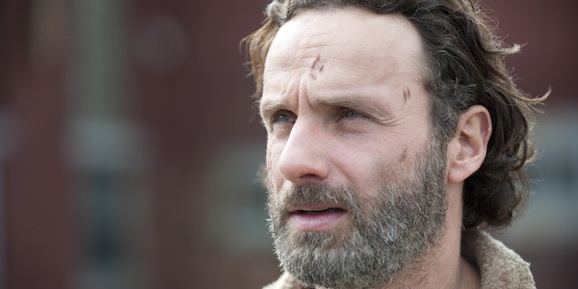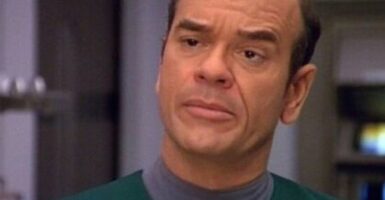The Walking Dead: Season Four Report Card
This article is more than 2 years old
 By the end of episode number eight, “Too Far Gone,” everything sucks. The Governor and his cronies have breached the prison walls, everything the survivors have worked to build lies in smoldering ruins, and in order to survive, the crew is forced to abandon their sanctuary and scatter in a dozen different ways. They’re beaten, bloody, broken, unsure if their friends and family are alive, and in some cases, knowing they’re very, very dead.
By the end of episode number eight, “Too Far Gone,” everything sucks. The Governor and his cronies have breached the prison walls, everything the survivors have worked to build lies in smoldering ruins, and in order to survive, the crew is forced to abandon their sanctuary and scatter in a dozen different ways. They’re beaten, bloody, broken, unsure if their friends and family are alive, and in some cases, knowing they’re very, very dead.
This is where the second half of the season picks up, and this is also where Gimple and his writing team come into their own, putting their stamp on the series. And the result is not only a superior part of the season, but the best version of the show. From episode eight to episode 16 what you have is The Walking Dead as good as it has ever been. For the first time in its four-year history, the show is starting to live up to its considerable potential.
The best episode of season three, by far, is “Clear”—written by Gimple himself. A smaller, more contained story, the episode only involves Rick, Carl, and Michonne, and a familiar face from Rick’s past. It doesn’t feel the need to check in with every single cast member, and really shows how good, how emotional, and how compelling The Walking Dead can be.
With the group of survivors fractured as they are after the prison, the writers use this opportunity to take a similar approach. While you often check in with multiple splinters of the group, you spend extended periods with each segment, and even then, you usually only see a couple of the separate pieces, not every single one every week. In “Still,” for example, there are literally two people, Daryl (Norman Reedus) and Beth (Emily Kinney), and it is not only one of the best episodes of the season, but one of the best of the series. Two characters talking, limited action, and it is a fantastic episode of TV.
This strategy, which very clearly has Gimple’s fingerprints all over it, allows for more character development than you’ve ever seen before on The Walking Dead. Michonne is a prime example. Since her introduction at the beginning of season three—or the very tail end of season two if you prefer—she’s been a functional mute, to the point where she could easily diffuse deadly conflict if only she’d uttered a handful of syllables, but she still says nothing. She had zero personality aside from a scowl and a sword. Over the course of a few episodes, she becomes more of an actual character, less a type, than she ever has been before. When she stumbles across Rick and Carl at the end of “After,” the first episode back, and breaks down in tears, it is the most earnest, emotional, and real that you’ve ever seen her, and over time you witness her develop a legitimate, earned bond with the younger Grimes.
This goes for every one of the survivors. The Maggie/Sasha/Bob Stookey branch is by far the most limited and stunted and one note, but still more complex and rewarding than most of The Walking Dead. The show takes its sweet time bringing the group back together, and is much, much stronger because of this choice. Worn down, on the verge of giving up as they are, the characters go through absolute hell—especially Tyreese (Chad Coleman) and Carol in “The Grove.” You’re right there with them as they plumb the depths of their souls, and as a result you learn so much more about them than you ever expected to.
Far from perfect, this is still easily represents the high point of The Walking Dead. The show introduces a trio of characters from the comics—Abraham (Michael Cudlitz), Rosita (Christian Serratos), and Eugene (Josh McDermitt)—but never has much use for them. Readers of Kirkman’s books know what a major role they’ll play in the future, but at the moment in the series, they’re just kind of there. While the season finale, “A,” starts strong, it peters out into bland action at the end. Though it does leave the key players in one hell of a predicament, it was the weak link in this portion of the season.
Like I said, season four of The Walking Dead is a tale of two halves, something that Gimple acknowledged on the season finale of Talking Dead, AMC’s live post-zombie talk show hosted by Nerdist’s Chris Hardwick. He acknowledges the necessity of reinvention, the need for the show to continually change and grow, and for the first time in four seasons, you feel like this is happening.
Pages [ 1 2 ]












